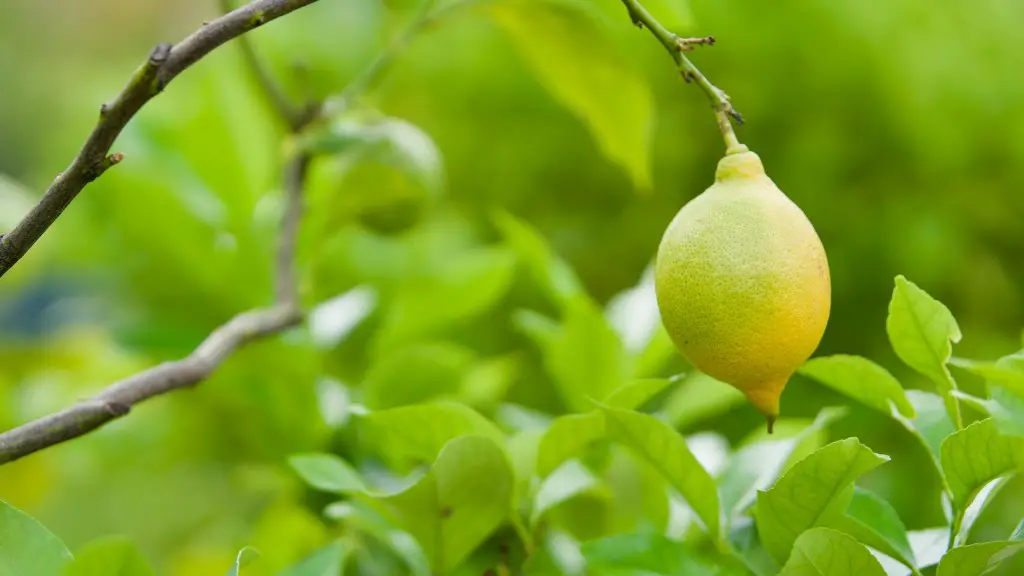Lemon trees require specific types of soil in order to grow and thrive. Although lemons can be grown in a variety of soil conditions, some types of soil are particularly suited to maximizing lemon tree growth and fruit production. In this article, we’ll discuss what type of soil a lemon tree needs and how to achieve an ideal soil environment for lemon tree cultivation.
Lemon trees perform best when grown in well-drained soils with a slightly acidic pH level of around 6.0 to 6.5. Sandy or loamy soils that contain plenty of organic matter in combination with nitrogen, phosphorus and potassium work well for lemon trees, but be sure to consult your local agricultural extension office for the best soil recommendations based on your specific area. If needed, soil can be adjusted to the optimal pH level for lemon trees by supplementing with a granular citrus-specific fertilizer.
Lemon trees also need regular and consistent watering for optimum growth and fruit production. When irrigating lemon trees, be sure to allow for a deep soak, as opposed to a light shallow watering. If puddles form on the surface after irrigation, the soil is too water-retentive and may require a little sand to help with drainage.
In addition to adjusting soil pH, adding organic material and ensuring adequate drainage, soil should also be mulched to help suppress weed growth, protect the root system and conserve moisture near the root zone. A layer of organic mulch, such as chopped leaves, hay, moss or pine needles, should be applied at least two inches thick around the base of the lemon tree.
Finally, it’s also important to regularly test your soil pH in order to ensure that your lemon tree is growing in its preferred soil environment. To do this, you’ll need a battery-powered soil tester which can be purchased from any gardening store. Taking the time to ensure that your lemon tree has the best soil possible is key to preventing issues with plant health and achieving abundant fruit production.
Preparing the Soil for Lemon Trees
When planting a lemon tree, it is important to pay close attention to the soil preparation process. It is best if the planting site is cleared at least two months before planting and the soil tested for pH. If the readings are off, the soil can be amended with lime or sulfur, depending on whether it needs to be more acidic or alkaline.
A planting hole should be dug that is slightly wider and deeper than the root ball. This gives the roots room to spread and encourages healthy development of the trees. Work plenty of organic compost into the soil to provide essential nutrition for the lemon tree and help amend any soil deficiencies. The compost will also help with moisture retention, so you don’t need to water as often.
When planting the lemon tree, be sure to keep the root ball at the same level as it was in the pot. Gently firm around the base of the tree and water well. Add a two- to three-inch layer of mulch over the root area to help with moisture retention and further discourage weed growth. For larger lemon trees, stakes may be needed to help steady the trunk and protect roots against heavy winds.
Fertilizing Lemon Trees
Fertilizing is an important part of the maintenance of lemon trees. When selecting fertilizer, use a citrus-specific fertilizer which contains nitrogen, phosphorus, and potassium. Fertilizers with too high an amount of nitrogen will undermine the health of the tree, and can lead to increased disease and insect pressure. Be sure to follow the instructions on the fertilizer label for proper application rates.
Fertilizing should begin in the spring when the buds of the trees start to swell, and should be applied every 6-8 weeks up until late August. It is best to broadcast the fertilizer evenly over the root area of the tree in the rate specified on the label. Once fertilizer has been applied, be sure to water it in order to ensure it is absorbed into the soil and reaches the lemon tree roots.
In addition to fertilizing, pruning of the lemon tree also needs to be done on a regular basis as this helps promote healthy growth by removing dead or dying limbs and controlling the size of the tree. Pruning should be done in late winter or early spring with loppers and shears, taking care not to remove too much at once.
Maintaining Proper Soil Nutrients
Every year, soil nutrients need to be replenished in order to nourish new growth and sustain healthy lemon tree development. A soil test should be conducted every three to four years in order to keep an accurate record of any soil deficiencies that need to be addressed. If soil readings are off, a commercial fertilizer or organic compost can be added to bring the levels back to normal. Organic compost also helps improve soil tilth and moisture retention.
To further ensure that soil has the essential nutrients for healthy lemon tree growth, roots can be fertilized by placing granules around the root area. If a liquid fertilizer is used, be sure to apply it directly to the root zone in order to ensure it reaches the roots.
It is also important to regularly mix the top layers of soil around the root area of the tree. This will help prevent compaction caused by extension and help by encouraging additional air and water penetration, which are both essential for healthy lemon tree growth.
Ensuring Good Drainage
It is vital to monitor the drainage of the soil in order to ensure that the lemon trees are benefiting from optimum growing conditions. Poor drainage prevents oxygen from entering the roots, while excessive water can prevent water and nutrients from reaching them. The soil should be tested multiple times a year to test for compaction and ensure it is stable enough for growing lemon trees.
If the drainage of the soil is poor, the surface should be modified by adding sand. This will help to improve water penetration and reduce the risk of waterlogging. If needed, trenches can also be dug nearby to help further improve drainage.
In addition to regularly testing for ideal drainage and soil compaction, it is also important to keep an eye out for any surface water. If standing water is present, it should be immediately diverted away from the root zone of the lemon tree. Improper water drainage can have severe consequences on the health of the lemon tree, and should be addressed promptly.
Watering Lemon Trees
In order for a lemon tree to remain healthy, adequate watering is required. During the first two years after planting, lemon trees require regular watering during dry periods. If natural rainfall isn’t sufficient, manually irrigate with a soaker hose one to two times per week, ensuring that the soil is saturated. It is a good idea to avoid sprinkling water over the surface of the tree, as this increases the chances of disease.
Once plants reach two years in age, they should be able to self-regulate their intake of water. During the summer months, regular monitoring of the moisture levels in the soil is important, as the trees will require watering more often if summer temperatures are high. When watering lemon trees, the soil needs to be soaked, not splashed with water. A soak of a few hours is usually enough.
It is also important to note that water should be applied in the morning, to allow the tree to make use of the moisture throughout the day. During hot and dry summer months, supplemental irrigation may be needed in order to prevent drought conditions which can lead to problems with leaf scorch.
Monitoring Soil pH Levels
Lemon tree growth and fruit production is dependent on having the right pH level for the soil in which it resides. The soil pH should be tested every year, preferably in the spring before the leaves begin to appear. The ideal reading should show a slightly acidic pH level of 6.5 or lower. If pH readings enter the alkaline range of 7.0 to 7.4, the soil can be adjusted with sulfur, and lime can be added if the pH falls below 6.0.
When adjusting the pH of the soil to the preferred level, it is important to do so on an annual basis. Constant monitoring of soil pH is essential, as the pH level can quickly move up and down depending on how much fertilizer is being used, how much rain and sun is present, and the types of soil amendments that are applied.
Overall, it is important to be aware of the type of soil in which a lemon tree is planted and to properly maintain it. Making sure that the soil nutrients, pH levels, and drainage are all in check, as well as pruning and fertilizing on a regular basis, will ensure that your lemon tree is provided with the necessary conditions for vigorous growth and abundant fruit production.





